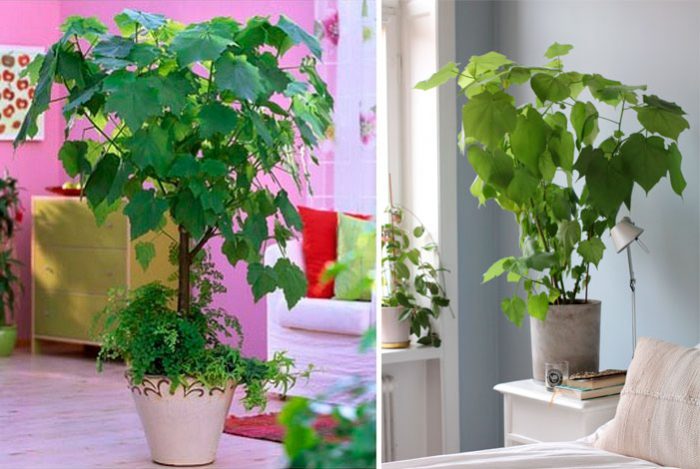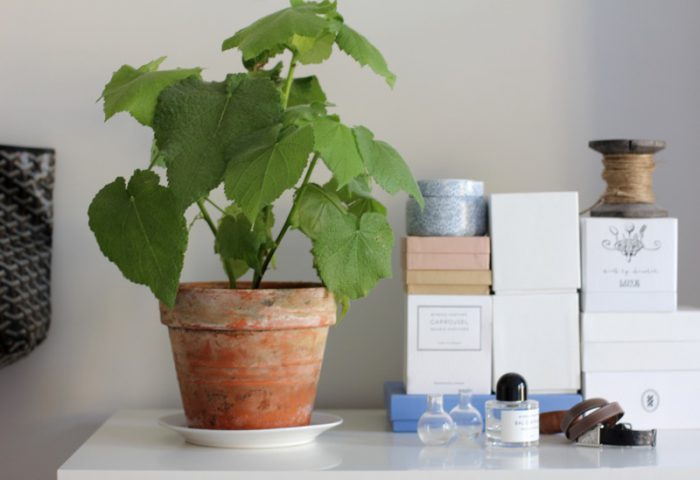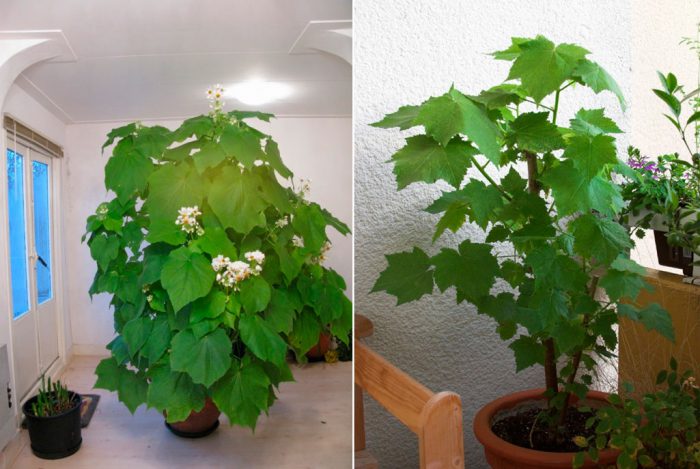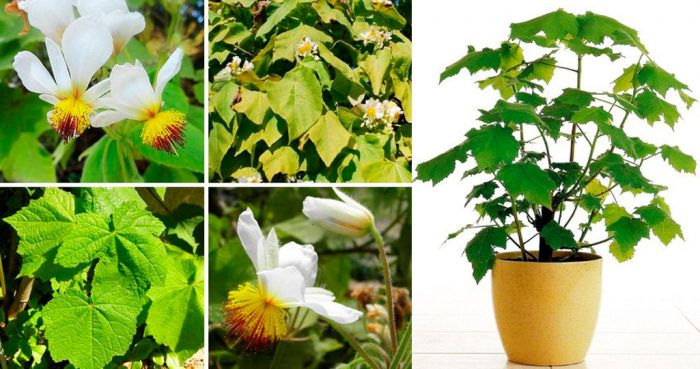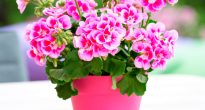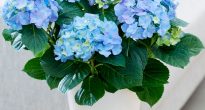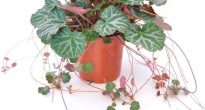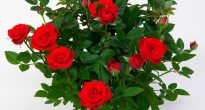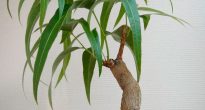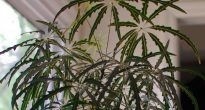A plant like sparmania has a more common name - indoor linden... For a novice florist, this plant may seem boring and not very spectacular. However, indoor linden is the largest tree that is grown at home, and it may well surprise its owners both pleasantly and not very much. The flowers of this plant are able to enchant with their unusual beauty, and the large leaves, which give a clear resemblance to trees growing in the wild, can fill the room with freshness and create coziness. When you look closely at sparmania, you begin to understand that it actually has a very effective and unusual appearance. However, despite all its beauty, such a tree is not so easy to grow at home. It is more capricious than many exotic plants and requires constant attention and compliance with all the rules of care.
Content
Sparmania in the interior
This tree is directly related to indoor giants. This is how plants are called, which over the years become very large shrubs or trees. Sparmania belongs to the mallow family, and it is equally beautiful both during the flowering period, when the tree is covered with lovely flowers, and the rest of the time. The birthplace of these beautiful "modest women" is South Africa and Madagascar.
Although the indoor linden is the most massive indoor plant, it can make any room cozy thanks to its unusual appearance. It is able to visually expand the room, while creating a variety of optical illusions. And this is all thanks to the large leaves, which create the impression of the airiness of the crown, and also the tiering of the silhouette is very noticeable in this plant. Compared to other large house trees, it is sparmania that can create the effect of a green jungle in the room, and at the same time it will not seem that the space is overweight. This tree can single-handedly decorate any room of the right size.
Features of sparmania African
The genus sparmania has many different species, but at the same time only one can be grown in an apartment - African sparmania (Sparmannia africana).But at present, there is a debate regarding the fact that African sparmania is a separate species (the same applies to other representatives of limes growing in South Africa). Today this tree has an uncertain status, since they are trying to attribute it to two different genera at once. Despite these disputes, flower growers are happy to grow this tree, referring it to a separate type of sparmania.
This evergreen plant is presented in the form of a shrub that develops in a tree-like form. Over the years, it often has one central rather thick stem. Over time, a rather graceful plant grows into a spectacular giant. Indoor linden can grow in height from 50 to 250 centimeters. Today, the most popular are dwarf forms that grow no higher than 80 centimeters.
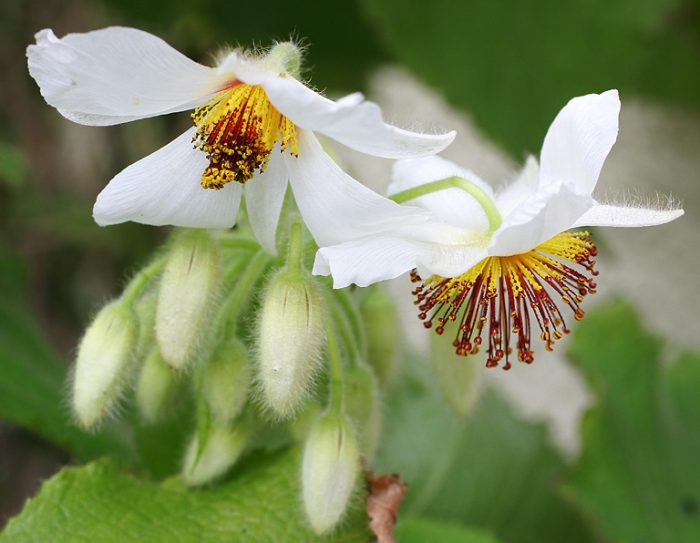
Young erect stems have a dull yellowish color, as well as pubescence. Over time, the bark becomes lignified and brown in color. The straight stems accentuate the airiness of the mating, and they are quite pleasant to the touch. However, touching the plant is not recommended, as contact with the leaves on the skin surface may cause irritation. The large heart-shaped leaves are divided into angular small lobes, which is very similar to a hybrid of mallow and grape foliage. Along the edge of the leaves are quite large denticles, which is why the foliage has a very sophisticated appearance, however, due to their monochromatic dark green color and large size, they may not seem as spectacular as in other decorative leafy plants popular among flower growers. By the way, the leaves as well as young shoots have pubescence on both sides.
Indoor sticky can charm anyone with its delicate bloom, which is reminiscent of primroses growing in the garden. The flowers are collected in umbellate inflorescences located on the top of the stems. The petals are painted white, but the long stamens, collected in bunches, have a rather bright color. So, at the base they are bright yellow, and at the edge - purple. The most spectacular flowers are given by the wavy edges of the petals, bent back. The buds are very delicate and somewhat reminiscent of cyclamen, but after they bloom, they radically change their appearance. So, a bright fluffy bunch of stamens sticks out from the center, and they are surrounded by snow-white translucent petals with a yellowish speck at the base, which create a semblance of a skirt. Delicate and very beautiful flowering is favorably emphasized by peduncles, on the surface of which there is also pubescence. There is a variety of African Sparmania "Flora Plena", which has very spectacular double flowers. Flowering is observed in winter. So, most often it begins in February and lasts until mid-spring, but it happens that flowers flaunt on a tree from December to March.
Sparmania care at home
This large shrub from a grower will require special attention and daily care. It is not suitable for inexperienced florists. Plus, indoor sticky takes up quite a lot of space and is suitable for growing in fairly spacious rooms. She just needs a cool wintering for normal growth and development. This plant needs fresh air and therefore the room should be regularly ventilated, which is very difficult, since sparmania reacts extremely negatively to drafts. The easiest to care for is feeding, watering and rare transplants. However, this plant loves moisture so much that maintaining it at a suitable level is a task for an experienced grower. However, despite all the difficulties, it is quite possible to successfully grow sparmania in an apartment.
Illumination
This plant simply adores the sun, and therefore should be placed exclusively in well-lit areas. In the summer, it should be borne in mind that direct sunlight should not fall on the foliage. However, the lighting must necessarily be good and even an average partial shade is not suitable for placing a tree.
Sparmania needs bright and diffused lighting throughout the year. Due to the fact that there is relatively less sunlight in winter, the tree should be moved to a more illuminated place. Best of all, during this period, the most illuminated window sill in the apartment is suitable. In the absence of a suitable well-lit place, additional lighting can be provided to the plant. She perfectly replaces natural lighting at this time. By the way, artificial lighting can replace natural lighting throughout the year, so indoor sticky feels quite well in the back of the room.
Temperature regime
This plant is characterized by a period of intensive growth and development, and a dormant period, while each of them has its own temperature. So, when the tree begins to actively grow, you need to try to keep the room constantly warm, but during rest it needs relative coolness. In the spring and summer, it is necessary to provide a temperature of 20-25 degrees. But even at a higher temperature, the plant will feel normal. However, only if the air humidity is also increased. With the onset of the autumn period and until the end of winter sparmania, it is necessary to provide a coolness of 10-12 degrees, which is quite problematic in an apartment with central heating. If the room is colder, then this can provoke a partial discharge of leaves, disrupt the development of the tree and even seriously damage it. If, during this period, the room sticky is put in a warm place, then the flowering can abruptly stop, and this will also have an extremely negative effect on the decorative effect of the crown.
However, this plant gives the grower more trouble because it hates stagnant air. And this implies frequent ventilation, and at the same time, it reacts negatively even to a relatively small draft. The air currents moving during ventilation can significantly harm the plant, especially if they are cold. In this regard, it must be protected from drafts as much as possible before airing begins. But it is even more complicated by the fact that sparmania has a very negative attitude towards stagnant air, and therefore the room should be ventilated regularly, even in winter. The plant also does not tolerate hot air currents coming from heating devices. If you place a tree next to them, this will worsen the decorative effect of the leaves, and in some cases, even spots may form on their surface. Indoor sticky should not be carried outside in summer.
How to water and moisture
Due to the fact that sticky has rather large leaves, it has a relatively high need for moisture. So, during the period of intensive growth, it must be watered abundantly, while the substrate in the pot must be constantly slightly moistened. Watering is carried out as the top layer of the soil dries up, after it dries out 1 centimeter deep, and it is better if it is not frequent, but very abundant. After 5-6 minutes after the plant is watered, the water must be drained from the pan. With the onset of the autumn period, the tree needs to be watered less and less each time. In winter, watering should be moderate and fairly rare. However, it is imperative to ensure that the soil in the pot does not dry out completely. To avoid overdrying the earthen coma, watering must be carried out after a day or two, after the top layer of the substrate has dried.
The difficulty of caring for sparmania lies in the fact that she is very fond of high humidity.This plant will feel great only if there is an air humidifier in the immediate vicinity of it, and you can do it yourself. Spraying indoor sticky is not recommended. The fact is that if large drops appear on the foliage, then a blackish speck will appear in this place, which will not disappear. Therefore, it is best to use the smallest spray nozzle for spraying, and spray water from the greatest possible distance. And it is best to carry out this procedure only when absolutely necessary. Due to the pubescence on the foliage, it is impossible to arrange shower for this plant, and still it is not necessary to wipe the accumulated dirt with a damp sponge.
Fertilizer
Sparmania should be fed only in the spring-summer period 3 times a month. For this, mineral and organic fertilizers are suitable, which must be applied to the soil alternately. They can be replaced with a complex mixture of a universal type. While the dormant period lasts, fertilization cannot be applied to the soil. And also the foliar feeding method should be excluded, because the plant reacts negatively to spraying.
Pruning
Indoor sticky, with spectacular foliage and lovely flowers, simply needs systematic pruning. With the help of this procedure, not only a spectacular crown is formed, but also the abundance of flowering increases, and the growth of stems is accelerated. Pruning should be done after the plant has faded. Experienced growers recommend only trimming a little tops of the shoots or trimming no more than a third of the stem. After this procedure, the intensive growth of sparmania will begin only with the onset of the spring period.
In the event that the leaves of the plant begin to fall off after flowering, deep pruning of the shoots is necessary, which will allow the tree to rejuvenate.
Both a young and an adult plant, in addition to pruning, will also need to regularly pinch the apical part of the stems. As a rule, only young branches of an adult plant are pinched, and this procedure is also carried out systematically in the first years of life at room temperature.
Features of the transplant and a suitable soil mixture
This plant does not have any special requirements for the soil mixture. So, in order to make a suitable earthen mixture, it is necessary to combine sheet and humus earth, with coarse sand, which should be taken in a 1: 2: 1 ratio. If desired, you can purchase ready-made universal soil in a special store.
Once a year, only young specimens are transplanted, which are relatively small in size. In the event that by the end of summer the young tree has grown very strongly, and the root system has filled almost the entire pot, it can be transplanted a second time. The main transplant should be carried out at the beginning of the spring period. An older large plant should be transplanted only once every 2-3 years and only after the roots become cramped in the old pot.
A suitable pot should be tall and not too wide. It is recommended to transplant by transshipment, while the earthen lump itself should not be destroyed. It is only necessary to replace the top layer of the earth. Be sure to add a sufficiently high drainage layer at the bottom of the pot.
Pests and diseases
Often they settle on spectacular large leaves mealybugs or spider mites... But it should be borne in mind that if you constantly maintain high humidity in the room, then problems with harmful insects should not arise. Sparmania is quite rare. A warm shower is often recommended to control such pests, but it is not suitable for this plant. It is best to treat it with special insecticides and place the tree in conditions appropriate for its normal growth and development.
The most common problems with growing linden are:
- The foliage loses its bright color, and brownish spots form on its surface - this is the fault of the direct rays of the sun falling on the plant.
- The leaves dry and curl - the room temperature is too high or the soil has dried out.
- The stems become elongated, gradually turn yellow and the foliage flies - the plant does not have enough light, move it to a place with more intense lighting.
- The growth of sparmania has stopped - this may indicate that the mode of fertilizing the soil is violated.
- The tree does not bloom - this may be due to improper wintering, as well as a lack of fertilizers during the period of intensive growth.
Reproduction methods
This plant can be propagated very easily and quickly. For this, both apical cuttings and seeds are used, while both in the first and in the second case, sufficiently strong and sturdy plants grow. Also, young specimens grown from both stem and seed grow quite quickly. So, in 1 year they become several times larger.
But how to propagate indoor linden with apical petioles?
Not every stem is suitable for cutting cuttings, but only a flowering one. Stem cuttings must be semi-lignified. They are cut off from the tops of the shoots, while they must have at least three nodes. It has been observed that petioles, which are 70 centimeters long, root best and fastest. For rooting, you can use a container with clean water, and perlite, sand, peat, as well as sand mixed with peat are perfect for this. It is very important for successful rooting to maintain a constant temperature of 20 degrees. In order for the roots to appear, as soon as possible before rooting, the sections must be treated with any means that stimulates their growth.
How can you grow indoor sticky from seeds?
The main condition for successful cultivation is the right time for sowing seeds. So, this procedure must be carried out exclusively at the beginning of the spring period. For sowing, you should choose a soil that is versatile and rich in nutrients. It must be sieved, and then the surface must be leveled with light movements so as not to compact. Seeds are sown to a depth of about one centimeter. Only after the sowing is completed can the soil be moistened. After that, the container should be covered with a transparent film or glass. To place a container with seeds, you need to choose a well-lit place on the windowsill, while you should not forget that the temperature should not be less than 20 degrees. The picking of seedlings in individual pots should be carried out only when they have real leaves. For 1 year, seedlings of room linden are transplanted several times. It is carried out every time after the root system has completely filled the pot. The capacity for transplantation should be taken only slightly larger than the previous one.


